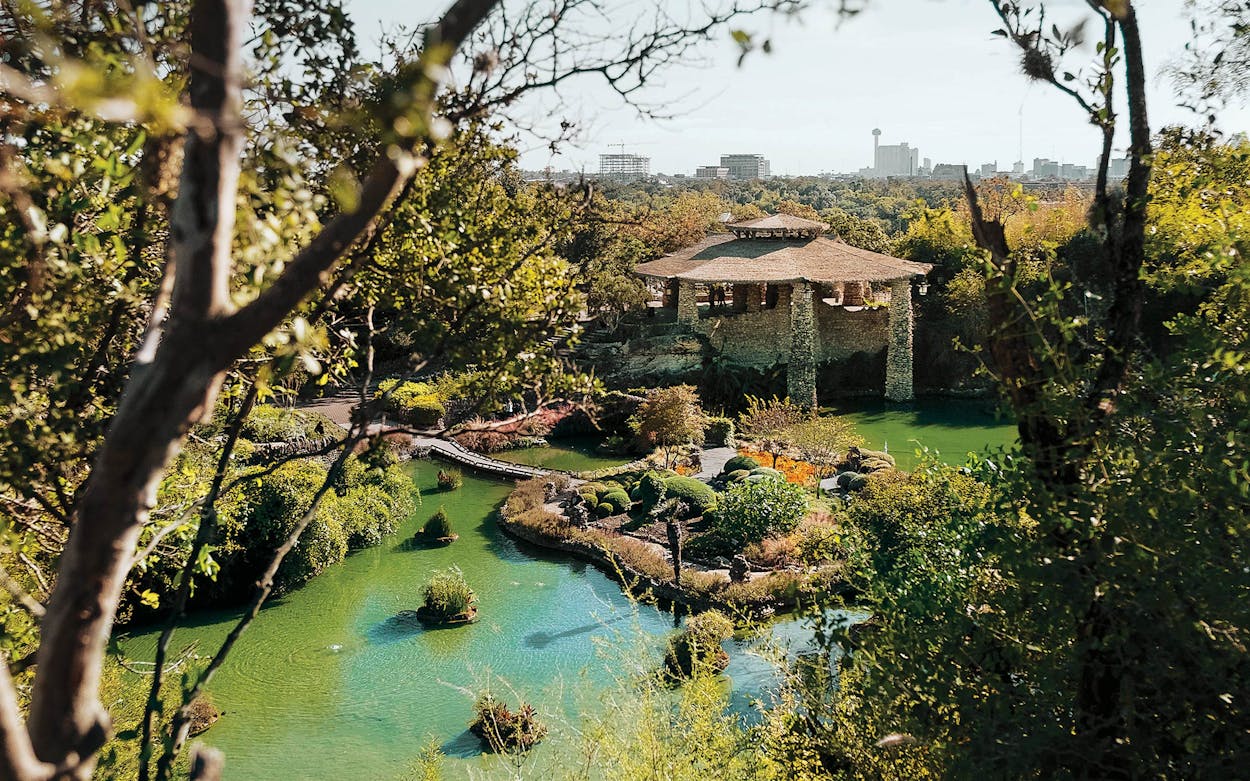Featured in the San Antonio City Guide
Discover the best things to eat, drink, and do in San Antonio with our expertly curated city guides. Explore the San Antonio City Guide
As they are wont to do, gardens grow all across the state despite hostile environments. Consider the botanical wonders of the Chihuahuan Desert, Old Garden Roses that resist drought and disease and neglect, and all the foliage that survived the February winter storm. You could say green spaces have even thrived in these turbulent times—sprouting up anew in backyards, as safe havens for the homebound and anxious turned budding garden enthusiasts—and for good reason. In addition to being pretty to look at, outdoor landscapes have long been studied for their ability to lower heart rates and even blood pressure. Feeling stressed? Immerse yourself in nature. The Japanese have a term for this calming practice: shinrin-yoku, or “forest bathing.” Of course, you don’t need an actual forest to reap the benefits, and the bathing bit is metaphorical—a stroll through any verdant patch will do. But by design, Japanese gardens in particular are an excellent choice for finding some peace, even here in Texas.
According to Nick Esthus, the Japanese Garden horticulture manager at the Fort Worth Botanic Garden, “green is the essential color” in a Japanese garden. “That’s why so many people find Japanese garden experiences so therapeutic,” he says. Simply put, the monochromatic palette imparts tranquility. And, dotted with artful arrangements of rocks, water, and intriguingly pruned shrubs and trees, the serene setting offers plenty of vignettes—like works in a gallery—on which to meditate: “Was that small tree clipped to emulate a cloud or a hill, I wonder?” “These stones remind me of little islands.” The grounds are also a safe space to settle onto a bench, rest your eyes, and zone out to the soothing rustle of leaves or trickle of a waterfall.
Winter happens to be a wonderful time of year to visit a Japanese garden, to take in cooler temperatures. Here are three of our favorites in Texas. And if you’re inspired to bring some zen-inducing elements to your own backyard, we have tips from Esthus below.
1. Japanese Tea Garden
San Antonio
At the heart of the eleven-acre Japanese Tea Garden, in Brackenridge Park, koi ponds fill the bottom of the former rock quarry that was developed into the garden in 1917. Take in the tranquil view from the open-air pavilion at the top and then follow the nearby winding path down a set of stone stairs, up and along arched bridges, and around the base of a sixty-foot waterfall. Sun streams in overhead, warming this sunken oasis in the cooler months. This park comes with a Texas twist: in lieu of classic Japanese maple or cherry trees, native and adaptive species abound, including leafy green Mexican sycamore trees and flower-studded desert willows.
2. Japanese Garden
Fort Worth
Completed in 1973, the Fort Worth Botanic Garden’s Japanese Garden is one of the state’s most traditional. Its seven and a half acres make for a leisurely stroll with lots to discover, including a “drum bridge” (named for the shape of its reflection in the water), a shaded pagoda, and a gravel garden. Thanks to interconnected ponds, you can hear gentle trickling from most corners of the retreat—and not much else. When the weather heats up, towering loblolly pines, oaks, and elms create a cooling canopy above the shorter and more customary Japanese maple, cherry, and ginkgo biloba trees.
3. Japanese Garden of Peace
Fredericksburg
This Hill Country tourist town beckons with its beer gardens, wineries, and other nods to its German heritage, but just off bustling Main Street, a discreet sanctuary can transport you to yet another world. Though part of the National Museum of the Pacific War, the Japanese Garden of Peace is accessible through a separate gate. Dreamy sculptural shrubs surround a raked rock garden in an intimate courtyard-like space that was built by Japanese artisans and opened in 1976. It’s an idyllic spot to rest your feet after a day of shopping and schnitzel.
An abbreviated version of this article originally appeared in the January 2022 issue of Texas Monthly with the headline “Serenity Now.” Subscribe today.
- More About:
- San Antonio
- Fredericksburg
- Fort Worth









